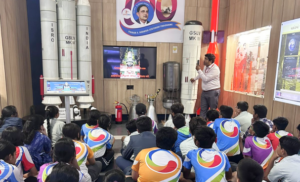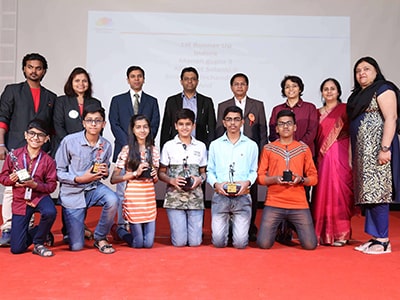Download our FREE Academic Calendar now! 📚 Start your child’s journey to success.
We all know academics and co-curricular activities in school go hand in hand to form a robust foundation for a student’s education. The co-curricular activities for students are more than just a hobby. They are essential to strike a perfect balance between a healthy mind and body.
To break the monotony of studying in a walled environment, the schools have introduced various types of co-curricular activities for the students. Every student gets the liberty to choose their favourite activity as per their interest. Let us understand in detail the importance of and types of co-curricular activities with examples.
What are the Co-Curricular Activities?
Alex is a bright student. All his teachers are proud of him. He is a dedicated student who scores exceptionally well in the examinations. He is very active in class and participates in all classroom discussions. He is also good at sports.
He is a great basketball player. What more? He loves to participate in school Olympiads and quizzes apart from being good at playing the harmonium. We are sure Alex knows how to manage his time well and manage a perfect equilibrium between his studies and the activities that boost his confidence.
All the activities that Alex participates in outside the classroom and help him stay motivated are called co-curricular activities. Co-curricular education boosts the endorphins in the students which trigger a positive feeling in the body of the students and help them perform better in academics as well.
One must know that co-curricular activities require an equal amount of dedication and determination as academics, only then can a student grow predominantly.
However, one must know a fine difference between extra and co-curricular activities before proceeding to the types and importance of co-curricular activities in detail.
The concept of co-curricular activities relates to an educational setup and in some way connects to academic learning. On the other hand, extra-curricular activities contribute zero credit to the educational realm and have an outdoor set-up for the students to freshen up.
Types of Co-curricular Activities
Did you know that co-curricular activities can be divided into multiple categories? Yes, the categories depend majorly on the motive and the skill of a student. Let us take you through the different types of co-curricular activities.
1. Co-curricular Activities for Physical Development
For physical development, the students can indulge in co-curricular activities like yoga, aerobics, Zumba, dance, sports, NCC, etc.
2. Co-curricular Activities for Cultural Development
The most common co-curricular activities performed for the cultural development of the students are drawing, painting, dance, music, theatres, plays, etc.
3. Co-curricular Activities for Social Development
The students can volunteer in school functions, conduct festivals or competitions, and take active initiation in social work for their social development.
4. Co-curricular Activities for Intellectual Development
The most popular activities for intellectual development are taking part in quizzes, debates, essay writing, extempores, poem recitals, story writing, spelling bees, book clubs, etc.
5. Co-curricular Activities for Psychomotor Development
The psychomotor activities include tasks like tailoring, bookbinding, gardening, knitting, etc. Psychomotor activities help to analyze the way your mind functions in different activities. These activities help to relax the brain muscles and support psychological development
Benefits of Co-Curricular Activities
The role of co-curricular activities in every student’s life is essential. It helps a student flourish in multiple areas of development in a well-structured way. Let us explore the importance of co-curricular activities for primary students.
1. Improves Academic Scores
It is the most common myth that if a student participates in co-curricular activities they are likely to perform badly in academics. However, the notion stands completely untrue.
The report cards of the students are the real proof that the students who are highly active in co-curricular activities also score exceptionally well in their academics. Their brain functions better and they attain great concentration power.
2. Uplifts Self-Confidence
A student must possess the qualities of self-confidence and self-esteem to build a strong academic profile.
Actively participating in co-curricular activities helps students experiment with their creations and develop something that boosts their confidence. It further helps them to achieve their goals and own a sense of pride.
3. Develop Talent & Skills
Co-curricular activities are the best way to help a student learn and develop new skills. A child gets a chance to discover their inner talent and know what gives their passion a kickstart. They are likely to discover and develop new talents and skills at an appropriate age.
Also Read: How to Identify your Natural Talents?
4. Extensive Social Skills
With a huge amount of opportunities to interact with a plethora of students during co-curricular activities, a student is liable to develop extensive social skills. They meet so many like-minded students and engage in conversations & activities over similar interests. It helps them to develop great communication and social skills from a very tender age.
5. Interdisciplinary Skills
There are plenty of essential skills and values that a kid develops over some time. A few of those skills that you may observe are-
● Logical and analytical thinking
● Problem-solving skills
● Leadership qualities
● Creative thinking
● Critical thinking
● Social values
● Ethical values
● Cultural Values
● Personality Development
● Technological skills
● Emotional skills
● Logical reasoning
● Communication skills
6. Time Management
One of the best key features of participating in co-curricular activities is that your child learns to manage their time efficiently. It is a skill that helps them perform well at all levels throughout their lives. A student learns what and how much time they should dedicate to an activity or a task and get their entire work done in a dedicated time frame.
Conclusion
The importance of co-curricular activities in a student’s life cannot be denied as it makes learning an exciting opportunity for them. These activities help the students relax, rejuvenate, and enhance their creative skills to a higher level.
Global Indian International School is the top Ahmedabad school that highly emphasizes the importance of co-curricular activities for the students of all the classes. It is the most renowned CBSE School in Ahmedabad that attracts students from various cultures and nations under one roof.
A student is bound to build nothing but a robust personality with great leadership qualities, time management, and communication skills. So, what’s the wait for? Enrol your child in Global Indian International School now for a seamless experience.
FAQs:
1. How do co-curricular activities improve academic performance?
Co-curricular activities in schools enhance academic performance by boosting concentration, improving brain function, and fostering discipline. Engaging in these activities helps students balance studies while developing essential skills and confidence.
2. Can co-curricular activities help reduce stress?
Yes, the benefits of co-curricular activities include stress reduction. These activities provide a refreshing break from academics, promote relaxation, and help students rejuvenate their minds, leading to improved overall well-being.
3. Are co-curricular activities beneficial for all students?
Co-curricular activities offer significant benefits for all students. They encourage personal growth, enhance social skills, and support academic performance, ensuring that every student can thrive in a balanced educational environment.
4. How can schools encourage student participation in co-curricular activities?
Schools can encourage participation by highlighting the importance of co-curricular activities in schools. GIIS Offers diverse options, organises events, and provides support to foster an engaging environment that motivates students to explore their interests and talents.





































